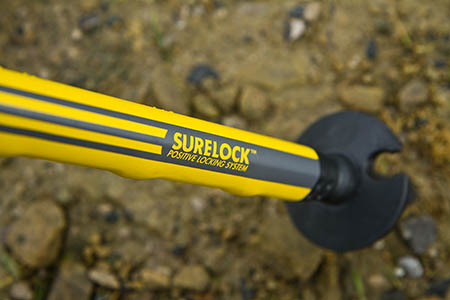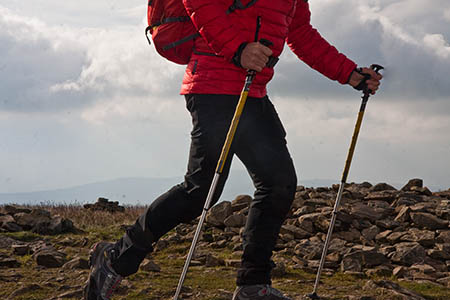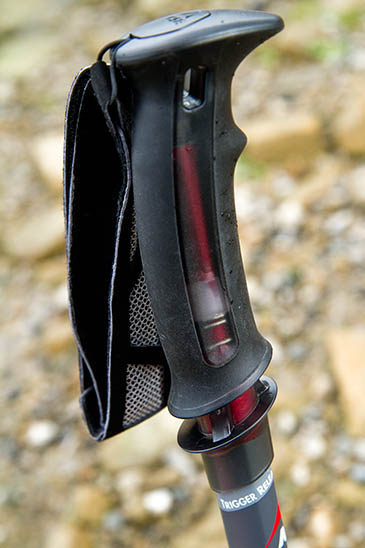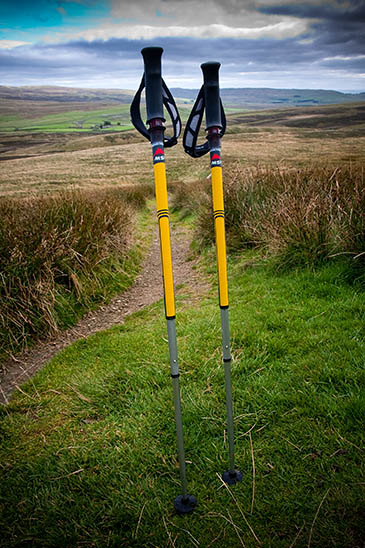MSR TR-3 Surelock Poles
Country of manufacture: China
Weight: 604g (pair)
Price: £105 a pair
Colour: mustard/black/silver
Material: 7000 Series aluminium
The use of trekking poles seems to divide the walking community.
Some swear by them; others swear at them. It’s certainly a hazardous activity following a walker carelessly flailing a pair of poles behind them. Keep your distance is our advice.
But what advantage is there to using poles?
We put Mountain Safety Research’s TR-3 poles to the test, with a pair provided by the Seattle firm.
The three-section poles come in two alternative lengths: standard and long. We had a pair of the long version, which telescope down to 61cm when fully retracted for storage or carrying. The standard version packs to 58cm and is a touch lighter.
The TR in the name denotes trigger release: a handy feature that allows a one-handed adjustment of the length from a maximum of 130cm to a minimum 105cm. To adjust, simply put your foot on the pole’s basket and lift the trigger with two fingers. This can be accomplished while the strap is in position round the hand.
This neat feature gets round one of the most annoying aspects of many poles: the necessity to tighten and loosen the friction joints to lengthen or shorten poles.
It’s also a source of failure on many models as weight is put on the poles which unintentionally partly collapse just when you probably need its rigidity most.
These MSR poles have the company’s Surelock system, which has an internal positive locking system that doesn’t rely on friction but has a set series of lugs that engage at given lengths at 5cm intervals.
This makes for very easy adjustment if, for example, you want to make one pole longer or shorter when contouring; extend them for downhill sections or collapse them completely when hands are needed on scrambly sessions.
The one curious feature is that, when fully collapsed the poles don’t lock at that length. It would be useful if they did to prevent them unintentionally extending if the basket is pushed into soft ground, for instance.
The straps have hook and loop adjustment strips. There is just enough length in them to allow them to be slipped over a pair of bulky winter gloves and still function properly.
The crook of the thumb and forefinger is where most of the weight should be placed while using the poles, rather than trying to grasp the grip tightly.
The straps have a soft inner lining.
The other advantage of the Surelock and Trigger Release mechanism is that it is in the top of the pole, meaning there is less of a moment from the lower end of the poles when swinging them in use.
Poles really have two major functions. On uneven terrain, they give extra ‘four-wheel-drive’ stability. This was particularly useful to me on a night hike in the Lake District with a particularly rocky descent down a gill.
The ability to steady yourself on uneven ground is a great advantage and potentially saves a slip that could lead to injury.
The other main use is to help propel you upwards when climbing hills.
With the correct technique, that is, with poles pushing backwards, the strain on legs is definitely reduced.
It’s probable that your overall energy output could actually increase, as you’re using your arms, shoulders and upper body to help the ascent, but it certainly felt like the legs took less of the effort when working hard on uphill sections.
You may or may not speed up the ascent. There is the additional need to concentrate on pole placement as well as foot placement.
I found this particularly the case on descents too, where the poles are used for balance rather than propulsion.
The poles give extra confidence during stream crossings too, with effectively an extra pair of legs to provide stability.
The MSR TR-3 Surelock poles are very easy to use and stow down to a small enough length to enable them to be packed on the rucksack when not needed or when technical, scrambly terrain is encountered.
The trigger mechanism and easy adjustability are a boon and eliminate one of the major bugbears of using walking poles: the fiddly friction adjustment mechanisms that seem to cause so much trouble to walkers I have seen on the hills.
The quality is as good as you would expect from MSR and the weight is not too much of a burden on a trip into the hills.
Although they’re at the top end of the poles price range, the ease of use justifies the outlay in my opinion. The poles now find a place strapped to my pack on almost all my trips.
Snow baskets, not supplied, can also be obtained for the poles.
Performance 32/35
Convenience 31/35
Design 8/10
Quality 8/10
Value for money 5/10
Total score: 84/100
More details on the MSR website.



